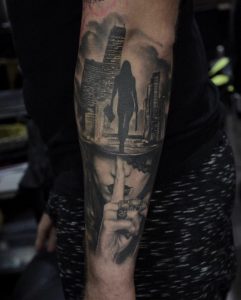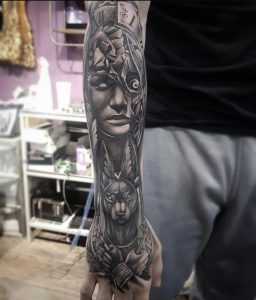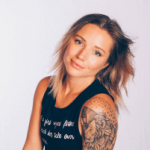Tattoo Glossary O – S
O
Old School — also known as American Traditional. Features bold black lining, two-dimensional with no shading, and draw from a set of images and symbolism, like eagles, skulls, roses, and pin-up girls.
Ornamental — in architecture and decorative art, an ornamental piece is one that is used to enhance or embellish a building or a painting. And so it is with ornamental tattoos and the body. They are inspired by Ancient Greek, Roman and Indian art and while they resemble geometric tattoos the positioning is most often done in a way that flows with the natural shapes and curves of the body.
P

Portfolio — a collection of an artist’s previous work and illustrations to show off their skills and style. While the folder and print version still exists, most showcasing today is done digitally and on social. Nothing has done more for the large-scale marketing potential for tattoo artists than the advent of Instagram.
R
Realism — most commonly done with portraits, animal depictions, and landscape motives. Accurate representation of light sources is crucial to making an image look realistic, as is mastery of shading techniques and proportion. They can be done in both black and grey and colour.
S
Sailor Jerry — Norman Keith Collins, a tattooist active in the 1920s and 1930s working on, not surprisingly, sailors. One of the most iconic artists due to his influence in popularising American Traditional, he practised on bums in Chicago whom he would pay with some change or a bottle of cheap wine. Having joined and later left the navy, he settled on Hawaii, tattooing other sailors on shore leave.
Scarification — another form of permanent body modification where intentional scarring, burning or etching the skin is used to create words or other designs.
Scratcher — someone who tattoos without having had training, sort of learning as they go along. Unfortunately, sometimes also without the proper health care regulations or sterilisation of equipment.
Single Needle — very small needle which allows the artist to add more detail in a smaller space and be a little more precise. They are used mostly for smaller black and grey tattoos with fine, graphite grey lines with an airbrushed quality to the shading.

Sleeve — typically, this is used to describe a full-arm tattoo, as is quite apparent by the name. However, it can also be utilized when someone has their entire leg tattooed, then it is known as a ‘leg-sleeve’.
Stencil— the artist uses a tattoo stencil to transfer the design from paper onto your skin. This gives the artist the basic outlines to work with.
Studio — the place where artists congregate and do their stuff. Usually very buzzy from the machines, but quiet from the concentration. They have permanent artists, and often guest artists travel through for a few days, a week, or even a couple of months. A studio works with by-appointment custom-made pieces, whereas a shop will also take walk-ins.
